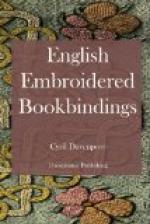[Illustration: 43—Psalms. London, 1633.]
On the lower board within the oval is a vine, with curving stem and two large grape clusters, tendrils, and leaves, growing from a small green mound. The edges of the petals are bound with a fine gold twist, as are also the edges and outlines of the leaves, and most of these parts are worked in coloured silks, mixed with fine metal threads, in needlepoint lace-stitch.
A few hazel-nuts are scattered about outside the gold oval, and in each corner is a further ornamentation: a reddish butterfly with wings of needlepoint lace in relief and edged with a gold cord, a green parrot with red wings and tail, are in the two top corners, and in the two lower are a rabbit and a dog, each on a small green ground. Innumerable gold spangles are all over the sides and back, each kept in place by a small pearl stitched through.
The back is divided into five panels, by rows of pearls, and a conventional flower is in each, except the centre one which has an insect. These are all worked in needlepoint and edged with gold twist, the stems of some of them strongly made by a kind of braid of gold cords.
This little book is certainly one of the most ornamental specimens of any of the smaller satin-bound books of the seventeenth century, and although here and there some of the pearls are gone, altogether it is in very good condition, and it is rarely that such a fine example can now be met with in private hands.
Bible. London, 1638.
[Illustration: 44—Bible. London, 1638.]
Several of the embroidered books on satin are worked chiefly in metal threads, and the designs on such books are not as a rule good. Whether the knowledge that the work was to be executed in strong threads has hampered the designer or not cannot be said, but certainly there is often a tinselly effect about these bindings that is not altogether pleasing.
In the case of a Bible printed in London in 1638, bound in white satin, and measuring 6 by 3 inches, one of the chief ornaments is a cherub’s head, the face in silver and the hair and wings in gold. The working of this head and wings seems to me wrong. The face is, possibly enough, as well done as the material would allow, but the hair is made in small curls of gold thread, and the feathers of the wings are rendered in a naturalistic way with pieces of flat gold braid. This kind of realism is out of place in embroidery, and it is unfortunately characteristic of the English embroidered work of about this period, occurring generally on boxes, mirror frames, or the like, but only rarely on book-covers. The design is the same on both sides; a narrow arch of thick gold cord reaches about three-quarters up the side, and interwoven with it is a kind of cusped oval, with leaves, reaching up to the top of the book. The lower half of the arch is enclosed in a rectangular band of silver threads, broad and kept in place by




